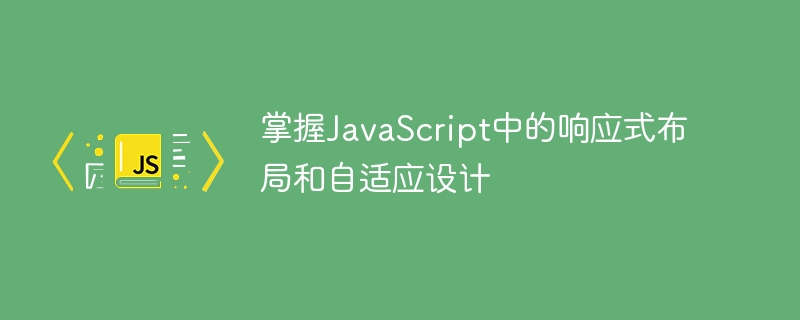

Mastering responsive layout and adaptive design in JavaScript requires specific code examples
In modern web design, responsive layout and adaptive design are very important Important concept. With the popularity of mobile devices, how to make web pages display well on different screen sizes has become a task for developers. JavaScript, as a commonly used scripting language, can help us implement responsive layout and adaptive design. This article will introduce some common JavaScript technologies and code examples to help readers better grasp these two concepts.
First, let’s introduce what responsive layout and adaptive design are. Simply put, responsive layout refers to dynamically adjusting and rearranging the layout of web pages for devices with different screen sizes to adapt to the display effects on various devices. Adaptive design refers to automatically adjusting the layout and style of web pages based on the characteristics of the device accessing the web page and the characteristics of the browser.
The realization of responsive layout and adaptive design is inseparable from the support of JavaScript technology. Below, we will introduce some common implementation methods and corresponding code examples.
1. Media Queries
Media queries are an important feature in CSS3 and the basis for implementing responsive layout. This feature allows us to apply different CSS styles on different screen sizes based on different device characteristics. JavaScript can dynamically adjust the conditions of media queries by listening to window size change events.
The following is a simple code example:
window.addEventListener('resize', function(event) {
if (window.matchMedia("(max-width: 600px)").matches) {
// 当窗口宽度小于600px时,应用移动设备样式
document.body.style.background = 'gray';
} else {
// 当窗口宽度大于等于600px时,应用桌面设备样式
document.body.style.background = 'white';
}
});The above code listens to the resize event of the window and applies the corresponding style according to the window width.
2. CSS Flexbox layout
Flexbox is a layout module of CSS that can realize flexible box layout. With JavaScript, we can dynamically change the parameters of Flexbox layout to adapt to different screen sizes.
The following is a simple code example:
window.addEventListener('resize', function(event) {
if (window.innerWidth < 600) {
// 当窗口宽度小于600px时,使用垂直布局
document.querySelector('.container').style.flexDirection = 'column';
} else {
// 当窗口宽度大于等于600px时,使用水平布局
document.querySelector('.container').style.flexDirection = 'row';
}
});The above code dynamically changes the direction of the Flexbox container according to the window width by listening to the resize event of the window.
3. JavaScript Viewport (Viewport)
The viewport refers to the visible area in the browser used to display web page content. JavaScript provides some properties and methods that can help us obtain, calculate and apply viewport-related information.
The following is a simple code example:
window.addEventListener('resize', function(event) {
var viewportWidth = Math.max(document.documentElement.clientWidth, window.innerWidth || 0);
if (viewportWidth < 600) {
// 当视口宽度小于600px时,应用移动设备样式
document.body.style.background = 'gray';
} else {
// 当视口宽度大于等于600px时,应用桌面设备样式
document.body.style.background = 'white';
}
});The above code obtains the viewport width by listening to the resize event of the window and applies the corresponding style according to the width.
The above are only some basic sample codes. The actual responsive layout and adaptive design need to be improved and optimized according to specific needs and design requirements. However, by mastering the principles and coding skills of responsive layout and adaptive design in JavaScript, we can better cope with devices of different sizes and provide a better user experience.
I hope the above content is helpful to you, and I wish you go further and further on the road of responsive layout and adaptive design.
The above is the detailed content of Master responsive layout and adaptive design in JavaScript. For more information, please follow other related articles on the PHP Chinese website!
